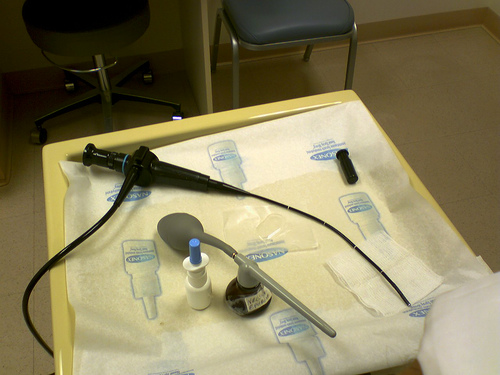
RHINOSCOPY - A new tool for common problems
Simply stated, fiberoptic rhinopharyngolaryngoscopy (rhinoscopy, for short) is a new technique for examing the nose and throat. When you visit your primary doctor and he/she examines your nose and throat, only the front portion can be seen. Many diagnoses can be made by examining this area. But as we all know, complaints of nasal congestion, postnasal drainage, itching, bleeding and pain can occur further back in the nose and certainly down the throat. An infection can cause laryngitis and make our voices hoarse. Ears may pop, ring, and hearing may be decreased, even if your ears and eardrums appear normal. An infection or asthma may cause swallowing and upper airway breathing to be difficult. With the rhinoscope your doctor can examine the entire nasal passage, including the eustachian tube openings of the ear canal to the throat. He can also examine the tonsils and adenoids to determine size or look for infection, and be sure that the vocal cords are normal without nodules or blockage. He can also check the back of the throat above the vocal cords for signs of acid reflux (gastroesophageal reflux or GERD), a common trigger of asthma and one of the most common causes of chest pain.
Allergists and ENT doctors are the specialists trained to use rhinoscopes. If you are being seen in the clinic for a disorder of your airways, your specialist may want to examine these important areas. Although not difficult, the procedure takes a few minutes; if the clinic is busy, it may be necessary to schedule a separate appointment for the examination.
What is a rhinoscope and how is it used? The rhinoscope is a small, flexible plastic tube with fiberoptics for viewing the airway. The rhinoscope can be attached to a television camera to provide a permanent record of your examination. To do the exam, a decongestant (usually Afrin) is sprayed into the nose first, followed by a local anesthetic (usually lidocaine) to numb the area. As the scope enters the nose, you will feel that it's there and a little uncomfortable, but it won't hurt. During the examination of the nose, you may breathe through the nose or mouth, but when it's time to look at the back of the throat and vocal cords, your allergist will ask you to breathe through the nose, and not to swallow. Swallowing at this point won’t be dangerous, but could be uncomfortable. Sometimes the lidocaine drips down the back of the nose and numbs the throat; this usually goes away in a few minutes. If your examination has been recorded, your doctor can review the recording with you, if you wish.
Can children be examined? Almost nothing that happens in a doctor's office is popular with small children, and rhinoscopy is no exception. Older children put up with the procedure better than do some adults. With small children, it's best to ask the child to sit in a parent's lab. If the child is uncooperative and the exam is absolutely essential, sedation can be provided, but you will need to wait in the clinic until the sedative has worn off.
What if you have asthma? Rhinoscopy can be performed if you have asthma, but it is best for your breathing to be well controlled at the time of the exam. You should continue taking your medications. Recently, doctors have discovered an unusual disorder of the larynx and vocal cords which mimics asthma. Patients may have an "asthma attack" with a croupy sounding bark or cough, and may even visit the emergency room for help. Interestingly, medications used to treat asthma don't work well, and breathing tests in the allergists' office suggest the upper airway and vocal cords are involved. Rhinoscopy can then be used to examine these airway and cords and make the diagnosis, and the easiest may to make the diagnosis is to examine the vocal cords with the rhinoscope during an actual attack!
What if something's wrong with your nose or throat? Many nasal disorders respond well to medication. If any abnormality is found that is not likely to respond to medication, or if your allergist has questions about your examination, you will be referred to an ENT specialist. This is the best approach for both you and your child, and will address all of your questions and concerns.
|
|
|
|
|
|
|
|
|